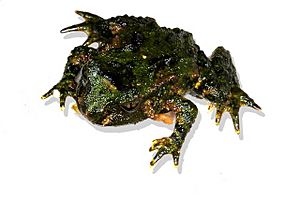Leiopelma facts for kids
Quick facts for kids Leiopelma |
|
|---|---|
 |
|
| Hochstetter's frog (Leiopelma hochstetteri) | |
| Scientific classification |
|
| Kingdom: | Animalia |
| Phylum: | Chordata |
| Class: | Amphibia |
| Order: | Anura |
| Suborder: | Archaeobatrachia |
| Family: | Leiopelmatidae Mivart, 1869 |
| Genus: | Leiopelma Fitzinger, 1861 |
| Species | |
|
See text |
|
 |
|
| Distribution of Leiopelmatidae (in black) | |
Leiopelma is a genus of New Zealand primitive frogs, belonging to the suborder Archaeobatrachia. It is the only genus in the monotypic family Leiopelmatidae. The leiopelmatids' relatively primitive form indicates they have an ancient lineage. While some taxonomists have suggested combining the North American frogs of the genus Ascaphus in the family Ascaphidae with the New Zealand frogs of the genus Leiopelma in the family Leiopelmatidae, the current consensus is that these two groups constitute two separate families. The four extant species of Leiopelmatidae are only found in New Zealand.
Overview
The New Zealand primitive frogs' defining characteristics are their extra vertebrae (for a total of nine) and the remains of the tail muscles (the tail itself is absent in adults, although it is present in the younger frogs, which need the extra skin surface until their lungs are fully developed). The family Ascaphidae (found only in North America), of the same suborder, shares these primitive characteristics, hence the two have often been described as related, or even part of the same family.
Late jump recovery is unique in Leiopelmatidae. When leiopelmatid species jump, they land in a "belly flop" fashion, repositioning their limbs for takeoff for the next jump only after hitting the ground with the ventral surface of their torsos. The appearance of early jump recovery in more advanced taxa is a key innovation in anuran evolution.
They are unusually small frogs, only 5 cm (2.0 in) in length. Most species lay their eggs in moist ground, typically under rocks or vegetation. After hatching, the tadpoles nest in the male's back, all without the need for standing or flowing water. However, Hochstetter's frog lays its eggs in shallow ponds and has free-living tadpoles, although they do not swim far from the place of hatching, or even feed, before metamorphosing into adult frogs. Lifespans may be long (more than 30 years) for such small organisms.
Introduced fauna are thought to have had a negative impact on these native frogs, with 93% of all reported predation events on native frogs being attributed to introduced fauna, primarily ship rats.
Species
Family Leiopelmatidae
- Genus Leiopelma
- Archey's frog, Leiopelma archeyi Turbott, 1942
- Hamilton's frog, Leiopelma hamiltoni McCulloch, 1919
- Hochstetter's frog, Leiopelma hochstetteri Fitzinger, 1861
- Maud Island frog, Leiopelma pakeka Bell, Daugherty & Hay, 1998
Extinct species
Three extinct species are known by subfossil remains, also from New Zealand. They became extinct during the past 1,000 years.
- †Aurora frog, Leiopelma auroraensis
- †Markham's frog, Leiopelma markhami
- †Waitomo frog, Leiopelma waitomoensis
Two unnamed species are known from the earlier Miocene deposits of the Saint Bathans fauna.
See also
 In Spanish: Leiopelmatidae para niños
In Spanish: Leiopelmatidae para niños

